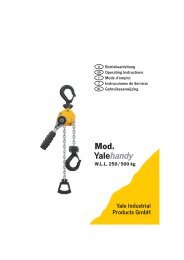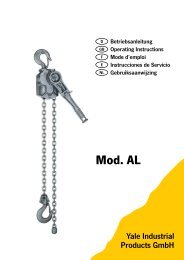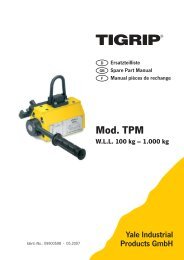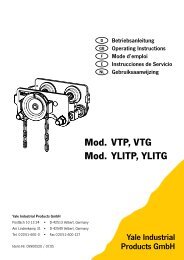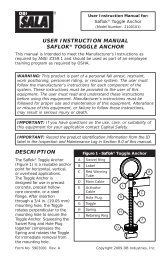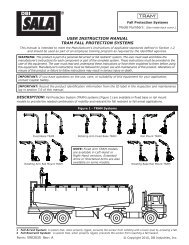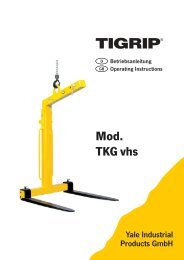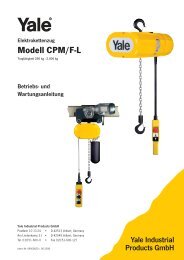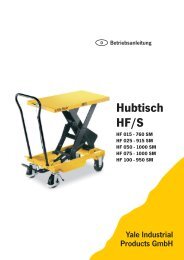jockey® & J5 - O. Rosinski GmbH
jockey® & J5 - O. Rosinski GmbH
jockey® & J5 - O. Rosinski GmbH
Sie wollen auch ein ePaper? Erhöhen Sie die Reichweite Ihrer Titel.
YUMPU macht aus Druck-PDFs automatisch weboptimierte ePaper, die Google liebt.
NL<br />
24<br />
telescopic operating handle on either the forward<br />
or reverse operating lever, lock it into position by<br />
twisting, and move the operating handle to and<br />
fro. The operating arc is variable for ease of operation.<br />
When operation stops, both jaws automatically<br />
grip the wire rope and hold the load which is<br />
spread equally between the jaws.<br />
The to-and-fro operation of the forward or reverse<br />
lever gives continuous movement of the load.<br />
7. RELEASING THE WIRE ROPE AND STORAGE<br />
7.1. Jockey<br />
When the work is completed take the load off the<br />
machine before attempting to release the jaws. To<br />
do this, operate the reverse operating lever until<br />
there is no tension in the wire rope<br />
Remove the sling and release the machine as<br />
follows :<br />
- release the mechanism by pushing the rope<br />
release catch towards the machine and upwards<br />
(Fig. 7.1).<br />
- pull the wire rope out with one hand while holding<br />
the machine by its rope release catch with the other<br />
hand (Fig. 10).<br />
- carefully coil the wire rope avoiding any loops or<br />
kinks.<br />
7.2. Jockey <strong>J5</strong><br />
When the work is completed take the load off the<br />
machine before attempting to release the jaws. To<br />
do this, operate the reverse operating lever until<br />
there is no tension in the wire rope<br />
Remove the sling and release the machine as<br />
follows :<br />
- release the mechanism by pushing the rope<br />
release catch towards the machine ;<br />
- at the same time, press the two catches, one on<br />
either side of the machine ;<br />
- release the rope release catch which should<br />
come out from the machine (pull it if necessary).<br />
(Fig. 8.1) ;<br />
- pull the wire rope out which one hand while holding<br />
the machine by its rope release catch with the<br />
other hand (Fig. 11).<br />
- carefully coil the wire rope avoiding any loops or<br />
kinks.<br />
8. SAFETY DEVICES<br />
8.1. Jockey<br />
Only use the operating handle supplied. Its length<br />
has been specifically set in accordance with the<br />
capacity of the machine. The handle breaks if the<br />
machine is overloaded.<br />
13<br />
8.2. Jockey <strong>J5</strong><br />
The Jockey <strong>J5</strong> has a shear pin which breaks<br />
should the machine be overloaded.<br />
To replace the shear pin :<br />
- Unscrew the 5 side case fixing screws.<br />
- Remove the side case and then the mechanism.<br />
Knock out the sheared pin with a 5 mm punch.<br />
Position one of the two spare shear pins located in<br />
the side case corner and drive it in with hammer.<br />
- Reassemble the machine.<br />
!<br />
Warning : It is forbidden to replace sheared<br />
pins by nonstandard pins. Use only genuine<br />
TRACTEL shear pins of the same model.<br />
9. WIRE ROPE<br />
To guarantee the safe operation of JOCKEY<br />
machines, it is essentiel to use them exclusively<br />
with TIRFOR wire rope which has been specially<br />
designed to meet the requirements of the<br />
JOCKEY machine.<br />
One end of the wire rope has a safety hook, fitted<br />
to a thimble fixed by a metal ferrule (see Fig. 12).<br />
The other end of the wire rope is fused and tapered<br />
(see Fig. 13).<br />
A wire rope in good condition is a guarantee of<br />
safety, to the same extent as a machine in good<br />
condition. It is necessary to continously monitor<br />
the state of wire rope, to clean and oil it with a rag<br />
soaked with motor oil or grease. Grease or oil<br />
containing graphite additives or molybdenum<br />
disulphide must not be used.<br />
Visual examination of the wire rope<br />
The wire rope should be examined daily to detect<br />
any signs of wear (damage or broken wires : see<br />
examples in Fig. 14).<br />
In case of any apparent wear, have the wire rope<br />
checked by a competent person. Any wire rope<br />
with a reduction from the nominal diameter by<br />
more than 10 % should be replaced. (see Fig. 15<br />
for the correct method of measuring the diameter<br />
of a wire rope).<br />
!<br />
IMPORTANT : It is recommended, specially for<br />
lifting applications, to ensure that the length of<br />
wire rope is greater than actually required. Allow<br />
an extra meter approximately.<br />
When lifting or lowering loads over long lengths of<br />
wire rope, steps should be taken to stop the load<br />
from rotating to prevent the wire rope from<br />
unlaying.<br />
Never allow a tensioned wire rope to rub over<br />
sharp edges. The wire rope must only be used<br />
with pulleys of an appropriate diameter.<br />
Never expose the wire rope to temperatures<br />
GB



